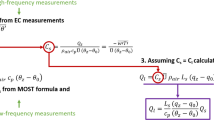Abstract
A one-dimensional, time-dependent cloud model with parameterized microphysics is used to investigate the processes which control the rainout and washout of soluble gases from warm, precipitating stratiform clouds. Calculations are presented simulating the distributions of soluble species within and below the cloud layer and in the precipitating raindrops as a function of time and species' solubility. Our calculations indicate that for species with low solubility, wet removal processes are relatively slow and thus do not significantly affect the species' gas-phase abundance. As a result, the removal of low-solubility species by rainout and washout is controlled by thermodynamic processes with the concentration of the species in cloud and rainwater largely determined by the species' solubility. For highly soluble species on the other hand, dissolution into cloud droplets and removal in rain is quite rapid and the abundance of highly soluble species within and below the cloud falls rapidly as soon as the precipitation begins. Because of this rapid decrease in concentration, we find that for highly soluble species: concentrations in cloud droplets near the cloud base can exceed that of raindrops by factors of 2 to 10; washout can dominate over rainout as a removal mechanism; and that, after an extended period of rainfall, the rate of removal becomes independent of the microphysical properties and rainfall rate of the cloud and is controlled by the rate of transport of material into the precipitating column by horizontal advection.
Similar content being viewed by others
References
BarrieL. A., 1985, Scavenging ratios, wet deposition, and in-cloud oxidation: an application to the oxides of sulphur and nitrogen.J. Geophys. Res. 90, 5789–5799.
Berry, E. X., Modification of the warm rain process,Proc. 1st Nat. Conf. on Weather Modification, Amer. Meteorol. Soc., Albany, New York.
BrimblecombeP. and DawsonG. A., 1984, Wet removal of highly soluble gases.J. Atmos. Chem. 2, 95–107.
BrowningK. A., HardmanM. E., HarroldT. W., and PardoeC. W., 1973, The structure of rainband within a mid-latitude depression,Quart. J. Roy. Meteorol. Soc. 99, 215–231.
ChameidesW. L., 1984, The photochemistry of a remote marine stratiform cloud,J. Geophys. Res. 89, 4739–4755.
ChangT. Y., 1984, Rain and snow scavenging of HNO3 vapor in the atmosphere,Atmos. Environ. 18, 191–197.
ChatfieldR. and CrutzenP. J., 1984, Sulfur dioxide in remote oceanic air: Cloud transport of reactive precursors,J. Geophys. Res. 89, 7111–7132.
ChockD. P. and DunkerA. M., 1983, A comparison of numerical methods for solving the advection equation,Atmos. Environ. 17, 11–24.
EasterR. C. and LueckenD. J. 1988, A simulation of sulfur wet deposition and its dependence on the inflow of sulfur species to storms,Atmos. Environ. 22, 2715–2739.
EnglemannR. J., 1971, Scavenging prediction using ratios of concentrations in air and precipitation,J. Appl. Meteorol. 10, 493–497.
GiorgiF. and ChameidesW. L., 1985, The rainout parameterization in a photochemical model,J. Geophys. Res. 90, 78720–7880.
GiorgiF. and ChameidesW. L., 1986, Rainout lifetimes of highly soluble aerosols and gases as inferred from simulations with a General Circulation Model,J. Geophys. Res. 91, 14367–14376.
HalesJ. M., 1982, Mechanistic analysis of precipitation scavenging using a one-dimensional, timevariant model,Atmos. Environ. 16, 1775–1783.
HeggD. A., RutledgeS. A., and HobbsP. V., 1986, A numerical model for sulfur and nitrogen scavenging in narrow cold-frontal rainbands. 2. Discussion of chemical fields,J. Geophys. Res. 91, 14403–14416.
HeymsfieldG. M., 1979, Doppler radar study of a warm frontal region.J. Atmos. Sci. 36, 2093–2107.
JungeC. E., 1963,Air Chemistry and Radioactivity, Academic Press, New York.
KesslerE., 1969, On the distribution and continuity of water substance in atmospheric circulations,Meteorol. Monogr. 10, 84.
LevinS. Z. and SchwartzS. E., 1982, In-cloud and below-cloud scavenging of nitric acid vapor,Atmos. Environ. 16, 1725–1734.
LiuJ. Y. and OrvilleH. D., 1969, Numerical modeling of precipitation and cloud shadow effects on mountain-induced cumuli,J. Atmos. Sci. 26, 1283–1298.
MahlmanJ. D. and SinclairR. W. 1977, Tests of various numerical algorithms applied to a simple trace constituent air transport problem, in I. H.Suffet (ed.),Fate of Pollutants in The Air and Water Environments, Vol. 8, John Wiley, New York, pp. 223–252.
MasonB. J., 1971,The Physics of Clouds, Oxford University Press, London.
QinYu and ChameidesW. L., 1986, The removal of soluble species by warm stratiform clouds,Tellus 38B, 285–299.
RutledgeS. A., HeggD. A., and HobbsP. V., 1986, A numerical model for sulfur and nitrogen scavenging in narrow cold-frontal rainbands. I. Model description and discussion of microphysical fields,J. Geophys. Res. 91, 14385–14402.
RyanJ. A., and MukherjeeN. R., 1974, Estimates of tropospheric HCl cycle, MDAC-WD, Paper No. 2290, Biotechnology and Space Sciences Subdivision, McDonnell Douglas Astronautics Company, Huntington Beach, CA.
SarmaR. A., 1983, Distribution of acidity in convective clouds due the aqueous-phase oxidation of sulfur dioxide by ozone-a numerical simulation,Precipitation Scavenging 1, 617–626.
SchwartzS. E., and FreibergJ. E., 1981, Mass-transport limitation to the rate of reaction of gases in liquid droplets: Application of oxidation of SO2 in aqueous solution,Atmos. Environ. 15, 1129–1144.
SchwartzS. E., 1986, Mass-transport considerations pertinent to aqueous phase reactions of gases in liquid-water clouds, in W.Jaeschke (ed.),Chemistry of Multiphase Atmospheric Systems, Vol. 6, Springer-Verlag, Berlin, Heidelberg.
ScottB. C., 1978, Parameterization of sulfate removal by precipitation,J. Appl. Meteorol. 17, 1375–1389.
SimpsonJ. and WiggertV., 1969, Models of precipitating cumulus towers,Monthly Weath. Rev. 97, 471–489.
SperberK. R. and HameedS., 1986, Rate of precipitation scavenging of nitrates on central Long Island,J. Geophys. Res. 91, 11833–11839.
StedmanD. H., ChameidesW. L., and CiceroneR. J., 1975, The vertical distribution of soluble gases in the troposphere,Geophys. Res. Lett. 2, 333–336.
StewartR. W., HameedS., and MatloffG., 1983, A model study of the effects of intermittent loss on odd nitrogen concentrations in the lower atmosphere,J. Geophys. Res. 88, 10697–10707.
WeathersK. C., LikensG. E., BormannF. H., BicknellS. H., BormannB. T. DaubeB. C.Jr., EatonJ. S., GallowayJ. N., KeeneW. C., KimballK. D., McDowellW. H., SiccamaT. G., SmileyD., and TarrantR. A., 1988, Cloudwater chemistry from ten sites in North America,Environ. Sci. Technol. 22, 1018–1026.
Author information
Authors and Affiliations
Rights and permissions
About this article
Cite this article
Xing, L., Chameides, W.L. Model simulations of rainout and washout from a warm stratiform cloud. J Atmos Chem 10, 1–26 (1990). https://doi.org/10.1007/BF01980035
Received:
Revised:
Issue Date:
DOI: https://doi.org/10.1007/BF01980035




